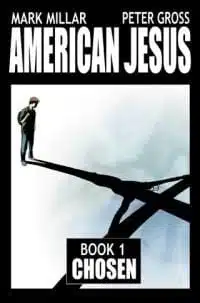
American Jesus: Chosen, collects the first three issues of the Mark Millar and Peter Gross’ collaboration featuring the Lamb of God, who has finally returned to Earth as a horny, kind of annoying pre-teen. After surviving a terrible accident without a scratch, Jodie Christianson begins to exhibit Christ like powers. Now all he has to do is convince the rest of the world that he’s the real deal.
Millar’s story is good, but not great. His most striking success is in crafting a believable messiah out of an average suburban kid who happens to also be kind of a jerk. By turns confused, selfless, responsible and arrogant, Millar’s returned savior is everything you’d expect out of an everyday American kid who suddenly found out he was the son of God, a well meaning goober whose human failings prevent him from living up to an impossible standard. What rings most true in Jodie is a streak of aloof, arrogant showoff that would come naturally to any preteen who discovered that they were literally the most important person on Earth. Unfortunately, Millar’s finely crafted main character is hampered by a hackneyed supporting cast of two dimensional bit players. From the Fallen Priest to the School Bully, the Cuckolded Husband to the Wise, Mysterious Old Black Woman, every player in American Jesus who isn’t the messiah is straight out of central casting.
Gross’ backgrounds are wonderfully eye catching. They are simultaneously realistic and dreamlike landscapes that are brought to their full power by the washed out, stylized coloring provided by Jeanne Gross. Unfortunately, not everything measures up to the promise found in his larger scale sequences, like the beautiful and terrifying image of an eighteen wheeler in free fall, crashing down among a flurry of autumn leaves. Gross’ characters have a half finished feel to them, as if no one face or figure has been rendered fully enough to distinguish it from its peers. Considering how little Millar’s script gives Gross to work with, it’s a forgivable, perhaps even intentional sin. After all American Jesus is, like the New Testament, the story of the savior, not the saviors interesting friends and family. Even if it is intentional, it’s a less-than-effective style of storytelling that results in a world that draws in its audience, but is populated by people the reader can’t relate to.
It would be hard to call 0American Jesus bad, per se, though it’s certainly far from the best work produced by either Millar of Gross. It is an occasionally clever and always tightly-plotted tale that, despite treading relatively fresh narrative ground, feels distinctly blasé.
But at the end of the day, with director Matthew Vaughn hoping to get a summer start on filming before the second book in what has become a planned trilogy is published this fall, American Jesus is most notable for what it says about the relationship of comics and films in the future. The collection from Image is already blurring the lines between cinematic release and comic book, including DVD style special features, such as creator commentary and interviews with outside authorities on the subject matter (a pair of very eloquent monks, in this case) alongside more traditional trade paperback goodies like sketchbook samples and pages of original script.
Like most longtime comic readers, I’ve come to terms with the fact that we’re going to continue seeing out favorite funny books transformed into big screen bonanzas with frustratingly mixed effect. For every fun, true to form Spiderman adaptation, we’ll be subjected to a grueling, rage inducing Daredevil. For every Ghost World, there will be a Ghost Rider.
Naturally, any sort of adaptation from one medium to another is a gamble, but in the case of translating comic books into feature films, it seems to be a particularly sharp double edged sword. Coming from a medium that, like cinema, depends on a combination of striking images, compelling storytelling and sharp dialogue to succeed, comics lend themselves to filmic adaptation. And as a medium that’s been maligned by general audiences, cinematic adaptations are an matchless tool for introducing wider audiences to underappreciated works of art.
All the same, American Jesus could have generations of True Believers fretting over the implications for the future of the industry. The idea that comics no longer being made just for the sake of being comics is a disturbing one, as is the notion of the comics industry being turned into a sort of farm system for Hollywood talent, where any book worth its salt is just waiting to become the next in line for translation to summer blockbuster fodder.
If creators start writing comics with visions of Hollywood option dollar signs dancing in their heads from the start, the quality and diversity of work in the field seems bound to suffer. Comics could become glorified storyboards rather than works of art in their own right. Creators with movies in mind will be less beholden to the tradition and history of the genre, and less inclined to experiment with the medium in ways that make it a growing, healthy art form. Thanks to a lively underground and alternative scene of small publishers and devoted artists and writers, there’s little doubt that we’ll still have comics made by people who just want to make comics. But in the case of bigger publishers, many of whom were in dire financial straits prior to the influx of movie megabucks, severing the bond between mainstream comics and the Hollywood machine at this point might just take a miracle.
